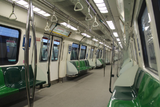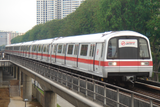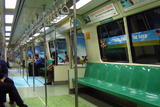Difference between revisions of "Kawasaki Heavy Industries 151"
m |
m |
||
| Line 136: | Line 136: | ||
{{Mass Rapid Transit}} | {{Mass Rapid Transit}} | ||
{{North South Line}} | |||
{{East West Line}} | |||
[[Category:Train Rolling Stock]] | [[Category:Train Rolling Stock]] | ||
Revision as of 12:03, 13 May 2018
Kawasaki Heavy Industries C151 are the first generation of trains running on the North–South Line and the East–West Line. These trains were manufactured from 1986 to 1989 in batches by a Japanese consortium consisting of Kawasaki Heavy Industries, Nippon Sharyo, Tokyu Car Corp, Kinki Sharyo under the Contract 151. No visible differences can be found in any of these batches, which were built to agreed specifications.
The trains underwent mid-life refurbishment program from 2006 to 2008 by Hyundai Rotem. Certain trains also have its Traction Control replaced to further enhanced operations reliability.
History
The Japanese consortium of Kawasaki Heavy Industries with Nippon Sharyo, Tokyu Car Corp and Kinki Sharyo was awarded Contract 151 in 1984 at a cost of $581.5 million for the construction of 400 passenger cars.[1]
Refurbishment
On 3 September 2004, Hyundai Rotem, Mitsui, RM Transit Technology and dU LexBuild received an order to refurbish all 396 carriages at a cost of $142.7 million.[2] The works included the refurbishment of interior fixtures, the addition of wheelchair spaces, the upgrading of onboard communications equipment, enhancement of the public announcement system, and general improvement of the cars' appearance.[3] SMRT said the reasons for refurbishment were wear and damage of important components over the past two decades and water leaks from the air-conditioning system on some trains.[3] The company chose this option instead of buying new rolling stock, which would have cost S$792 million.[3] All trains has finished refurbishment in end-2008, marking the 2 years refurbishment programme.
Upgrading
Following the 2011 major train disruptions, SMRT announced it was replacing important engineering components on all C151 trains by 2019.[4] This included changing the existing Mitsubishi Electric propulsion system for the newer Insulated-gate bipolar transistor (IGBT) and Permanent Magnet Synchronous Motor (PMSM) propulsion system by Toshiba.[5]
In tandem with the replacement of the signalling system on the North South East West Lines with the newer Thales SelTrac signalling system, new equipment are installed in the passenger compartment of the trailer cars.[6]
Replacement
In October 2016, LTA announced that it will be calling for a tender of new trains to replace all C151 trainsets.[7]
For the time being, LTA will work with SMRT to improve the reliability of the 66 first-generation trains until their replacement trains are ready.
Design/Features
Passenger Trains
| Initial | Refurbishment | ||
|---|---|---|---|
DT M1 M2 M2 M1 DT |
DT M1 M2 M2 M1 DT
| ||
| Exterior Design | |||
| Livery | White with red strip | Black,Red,Grey (Top to bottom) | |
| Train Run Number | Plastic Roller Blinds | ||
| Interior Design | |||
| Seating Capacity | 372 | Original | Bar Train |
| 296 | 212 (208 after signalling upgrade) | ||
| Wheelchair Bay | N/A | 2, 1 each at Third and Fourth Car | |
| Door Closing Indicator Lights | N/A | 3 Red LED (Top) | |
| System | |||
| Safety System | ATC, ATO, ATP | ATC, ATO, ATP, ATS (after signalling upgrade) | |
| Signalling System | Fixed Block | Fixed Block Communication Based Train Control (after signalling upgrade) | |
| Traction Control | 4-quadrant/GTO chopper control (Mitsubishi Electric) | 4-quadrant/GTO chopper control (Mitsubishi Electric) IGBT-VVVF (Toshiba PMSM) | |
Money Train
| Initial | |
|---|---|
DT M1 M2 DT
| |
| Exterior Design | |
| Livery | White with red strip |
| Train Run Number | Plastic Roller Blinds |
| Interior Design | |
| Seating Capacity | 248 |
| Wheelchair Bay | N/A |
| Door Closing Indicator Lights | N/A |
| System | |
| Safety System | ATC, ATO, ATP |
| Signalling System | Fixed Block |
| Traction Control | 4-quadrant/GTO chopper control (Mitsubishi Electric) |
Fleet Numbering
The car numbers of the trains range from x001 to x132 (for Passengers Trains) and x301 to x302 (for Money Train), where x depends on the carriage type.
- The first digit identifies the position of the car from the closest end of the train; where ‘3’ represents first car, ‘1’ represents second car and ‘1’ represents third car.
- (Example) Passenger Vehicle 131/132 would consist of 6 cars with serial number 3131, 1131, 2131, 2132, 1132 and 3132 respectively.
- (Example) Passenger Vehicle 301/302 would consist of 4 cars with serial number 3301, 1301, 2301, 3302 respectively.
- Depending on the direction of travel, the sequence may be reversed.
References
- ↑ "シンガポール向け地下鉄電車を納入". Kawasaki Heavy Industries (Archived). Retrieved 8 November 2008.
- ↑ "シンガポールにおける地下鉄電車改修案件の受注について". Mitsui (Archived, 3 September 2004). Retrieved 8 November 2008
- ↑ 3.0 3.1 3.2 "MRT trains get $145m overhaul". T. Rajan (Straits Times, 5 November 2006.
- ↑ "Older SMRT trains to get makeover for better ride". Royston Sim (Straits Times, 15 May 2013). Retrieved 13 May 2015.
- ↑ "Older MRT trains to get new motors from Japan". Hoe Pei Shan (Straits Times, 5 July 2013). Retrieved 13 May 2015.
- ↑ "Coming: $600m upgrade for MRT system/New train measures a ‘catch-up’". Joy Fang (My Paper,2 February 2012). Retrieved 13 May 2015.
- ↑ "The Rail Report: New Signalling System, Rail Line and Tuas West Extension Opening Next Year". Land Transport Authority.
| [ V • T • E ] | ||
|---|---|---|
| Overview | History • Stations • Fare and Ticketing • Facilities • Safety • Security | |
| Lines | North–South Line • East–West Line • North East Line • Circle Line • Downtown Line • Thomson–East Coast Line
FutureJurong Region Line • Cross Island Line | |
| Rolling Stocks | 151 • 151A • 151B • 151C • R151 • T251 • 751A • 751B • 751C • 830 • 830C • 851E • 951
Former651 Future J151 • CR151 | |
| Depots | Bishan • Changi • Gali Batu • Kim Chuan • Mandai • Sengkang • Ulu Pandan • Tuas | |
| Future Changi East • East Coast • Tengah | ||



